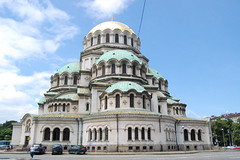Thanks to Easyjet's bargain basement prices, I found myself in Bulgaria's capital, Sofia.
When coming in to land at Sofia International Airport I was thinking, what do I know about Bulgaria...? All I could conjure up was Cyrillic script, bagpipes, wine and spies. It was a good excuse to find out more.
5 minutes out of the airport and I wondered if I was in the shantytowns of Johannesburg... or the slums of Bangkok. It seemed to be populated mainly by Sofia's Roma community living in row after row of sheet-metalled squalor, with a few chickens here and there.
10 minutes later I arrived in the city centre. Surrounded by snow capped mountains which serve as a thriving ski resort during the winter, and packed with ancient and communist style buildings, it was quite a contrast to my first impression. Sofia is one of the oldest cities in Europe, over 7000 years old, dating back to Thracian times.
Bulgaria has endured numerous seizures by the Macedonians, Romans, Byzantines, Huns, Slavonic tribes, Ottomans and Russians, and later the Allies during WWII, during which time Bulgaria sided with the Germans. Finally, the Russians came in, and Bulgaria was subjected to decades of communist rule.
It didn't take too much querying to reveal the disdain many Bulgarians still feel towards their communist history, and a mix of disgust and humour about the way revolutionary socialism has been popularised in the west, especially by those who have little or no experience or knowledge about the ideology and practice.
I had 2 days before my night train to Turkey so I asked the owner of my hostel about tours. It turns out he has a nephew who has worked as a guide so I was lucky enough to get a 3 hour private guided walking tour for about €10. He was very well educated in Bulgaria's ancient and more recent history and politics so I got a unique insight into the country.
Despite its current ethnic tensions,(http://www.alertnet.org/thenews/newsdesk/L16241089.htm )
Bulgaria has had a history of ethnic and religious tolerance. During World War II Bulgaria took a strong stand against Germany in relation to the holocaust, and managed to save every one of the over 50,000 Jews living in the country at that time.
It's of little surprise, then, that some of Sofia's most impressive buildings are religious in nature. I had a glimpse inside a mosque, the Sofia Synagogue and the Russian church. As far as tourist sights in Sofia go, one of the city's most well known and beautiful is the Eastern Orthodox St. Alexander Nevsky Cathedral, one of the largest of its kind in the world. With its gold plated dome and marble interior, it's a beautiful sight.
When I was all churched-out I wandered around the markets, which sold everything from fresh cherries to books to religious icons. 8 hours later and I felt I had seen most of the city. After a feast of roasted garlic potatoes and Bulgarian wine I boarded the night train for Istanbul. It was time to go East.
Subscribe to:
Post Comments (Atom)



No comments:
Post a Comment